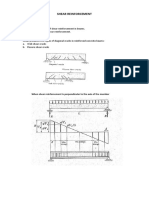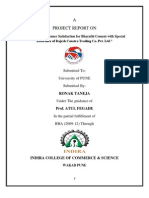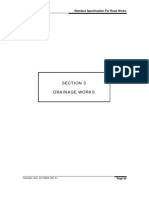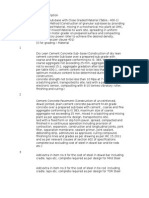Bond, Development Lengths and Splices
Uploaded by
Dong DimalantaBond, Development Lengths and Splices
Uploaded by
Dong DimalantaDIOSDADO B.
DIMALANTA, MSCE, MEMBER ASEP,ACECOMS
CE DEPARTMENT, CSU-ENGINEERING Page 1 of 11
REINFORCED CONCRETE DESIGN NOTES
CIVIL-STRUCTURAL ENGINEERING
Bond, Development Lengths, and Splices
The design ob beams is so far based on the maximum moments to
provide the calculation of area of steel reinforcement needed. The area
computed are based at midspan for positive reinforcement and near the
support for negative reinforcement. However, the moment varies with
distance at some points along the length allowing a reduction of area of
steel theoretically to reduce cost.
The figure shown below explains how bars can be reduced or cut-
off with moments as basis for the reductions. Assuming a beam with 6
bars as reinforcement, then the possible reduction can be theoretically be
cut as shown.
kN/m
DIOSDADO B. DIMALANTA, MSCE, MEMBER ASEP,ACECOMS
CE DEPARTMENT, CSU-ENGINEERING Page 2 of 11
REINFORCED CONCRETE DESIGN NOTES
CIVIL-STRUCTURAL ENGINEERING
BOND STRESS
The basic assumption in the design of concrete is, concrete
and steel reinforcement should act as one even if they are made of
different materials. It means that there is no slippage of steel bars with the
surrounding materials. The acting together is what we call Bond. If the
materials will not bond as one, and if steel bars are not anchored at its
end, then it will be pulled out of the concrete.
As a result, deformed bars are used in almost all concrete
works. Plain bars are also allowed to be used for lateral reinforcement in
compression members. Reinforcing bars are made of rib type
deformations and thus, bond is supplied by the bearing on the ribs as
shown.
To illustrate the type of bond failures on concrete, the figure
below provides a picture of how concrete splits depending on several
factors like, concrete that covers around the bars, spacing of bars, coating
on the bars, type of aggregates, transverse confining effect of stirrups etc.
DIOSDADO B. DIMALANTA, MSCE, MEMBER ASEP,ACECOMS
CE DEPARTMENT, CSU-ENGINEERING Page 3 of 11
REINFORCED CONCRETE DESIGN NOTES
CIVIL-STRUCTURAL ENGINEERING
DEVELOPMENT LENGTHS FOR TENSION
REINFORCEMENT.
To provide a monolithic behavior of the materials, the steel
and concrete, the bond stresses must be transferred to the concrete by
bond between the steel and concrete before the bars are cut off. In this
case, the bars must be extended some distance back into the support and
out into the beam to anchor or develop their strength, this extended
distance is what we call as Development Length, l
d
as shown in the
figure below.
ACI Equation 12-1
b
b
tr
c
y
d
d
d
k c
f
f
l
|
|
.
|
\
|
+
=
'
10
9
o|
|
|
.
|
\
| +
b
tr
d
k c
shall not be taken greater than 2.5.
sn
f A
k
yt tr
tr
10
=
, transverse reinforcement index.
This equation provides a result in terms of diameter of bars
being used in the design. The values of the different coefficients are given
in ACI 12.2.4 or NSCP 412.3.4
DIOSDADO B. DIMALANTA, MSCE, MEMBER ASEP,ACECOMS
CE DEPARTMENT, CSU-ENGINEERING Page 4 of 11
REINFORCED CONCRETE DESIGN NOTES
CIVIL-STRUCTURAL ENGINEERING
NOTE:
1. ACI 12.1.2, the value of
'
c
f used in the equations shall
not exceed 25/3 Mpa.
2. ACI 12.2.5, Excess reinforcement.-reduction in
development length may be permitted. The l
d
/d
b
may be
multiplied by (A
s ,required
/ A
s, provided
).
DEVELOPMENT LENGTHS FOR BUNDLED BARS
The use of bundled bars requires greater development
lengths because there is not a core concrete between the bars to provide
resistance to slipping.
ACI 12.4.1 Development of individual bars within a bundle, in
tension and compression, shall be that for the individual bar, increased
20 percent for three-bar bundle, and 33 percent for four-bar bundle.
10 mm
stirrups
3-25 mm
DIOSDADO B. DIMALANTA, MSCE, MEMBER ASEP,ACECOMS
CE DEPARTMENT, CSU-ENGINEERING Page 5 of 11
REINFORCED CONCRETE DESIGN NOTES
CIVIL-STRUCTURAL ENGINEERING
HOOKS
In actual design implementation due to limited dimensions
of members or sufficient space is not available to anchor tension bars by
running them straight for their required development lengths, hooks may
be used to provide the necessary development length. (Hooks are
considered useless for compression bars for development length
purposes).
D=6d
b
for 10 to 25 mm
D=8d
b
for 28, 32, & 36 mm
D=10 d
b
for higher than 36 mm
DIOSDADO B. DIMALANTA, MSCE, MEMBER ASEP,ACECOMS
CE DEPARTMENT, CSU-ENGINEERING Page 6 of 11
REINFORCED CONCRETE DESIGN NOTES
CIVIL-STRUCTURAL ENGINEERING
ACI 12.5.1 Development length l
dh
for deformed bars in tension
terminating in a standard hook.
b
c
y
d
d
f
f
l
'
24 . 0 |
=
l
d
>8d
b
nor less than 150 mm
The development length l
d
is measured from the critical
section of the bar to the outer side end or edge of the hook as shown in
the figure.
4d
b
for 10 to 25 mm
5d
b
for 28, 32, & 36 mm
6d
b
for higher than 36 mm
DIOSDADO B. DIMALANTA, MSCE, MEMBER ASEP,ACECOMS
CE DEPARTMENT, CSU-ENGINEERING Page 7 of 11
REINFORCED CONCRETE DESIGN NOTES
CIVIL-STRUCTURAL ENGINEERING
DEVELOPMENT LENGTH FOR COMPRESSION BARS
For compression bars, there are no cracks that encourage
slipping, and the bearing on the ends of the reinforcement on
concrete helps develop the load, hence it is obvious that
development length for compression bars is smaller than those
required for tension bars.
ACI 12.3.2
For deformed bars and deformed wire, the l
d
shall be
taken as the larger of
b y d
c
b y
d
d f l
f
d f
l
) 0003 . 0 (
002 . 0
'
=
=
But l
d
200 mm
Note that 0.0003 has a unit of mm
2
/N
EFFECT OF COMBINED SHEAR AND MOMENT
DIAGRAM ON DEVELOPMENT LENGTHS
ACI 12.10.3
Reinforcement shall extent beyond the point at
which it is no longer required to resist flexure to a distance
equal to the effective depth of member or 12d
b
whichever is
greater, except at supports of simple spans and at free end of
cantilevers.
Commentary 12.10.3
The extension of effective depth of member or
12d
b
is to account for the shifting location of maximum
moment or inflection point due to changes in loading,
support settlement, application of lateral loads and other
factors.
DIOSDADO B. DIMALANTA, MSCE, MEMBER ASEP,ACECOMS
CE DEPARTMENT, CSU-ENGINEERING Page 8 of 11
REINFORCED CONCRETE DESIGN NOTES
CIVIL-STRUCTURAL ENGINEERING
BAR SPLICES IN FLEXURAL MEMBERS
Construction is the implementation of design phase of a
project. In actual situation, reinforcing bars are limited to standard
lengths of 6, 7.5, 9, 10.5, 12 and 13.5 m. The splicing of bars is
necessary to provide continuity of reinforcement, hence, locations
and types of splicing is very important to be specified by the
designer.
The most common method of spicing is Lapping. The code
requires that lapping is only allowed for diameters 36 mm or
smaller. However, lap splicing may not be satisfactory for several
situations where it may cause congestions, lap maybe very long,
and big diameters like 36 mm and above are not permitted by the
code.
Splices should be located away from location of maximum
tensile stresses. Furthermore, the bars should not be spliced at the
same locations- that is splices should be staggered as required by
the code.
TENSION SPLICES
ACI 12.15.1 Stipulates the two type of splices into two;
Class A and Class B and it is dependent on the level of
stress and percentage of steel that is spliced at a
particular location.
Class A Splices are those where reinforcement is lapped for a
minimum distance of 1.0l
d
(but not less than 300mm) and
where one-half or less of the reinforcing is spliced at any one
location.
Class B Splicing are those where reinforcement is lapped for
a minimum distance of 1.3l
d
(but not less than 300mm) and
where all the reinforcing is spliced at same location.
Maximum percent
of A
s
spliced within
required lap length
A
s
provided
A
s
required
50 100
Equal or greater than 2 Class A Class B
Less than 2 Class B Class B
DIOSDADO B. DIMALANTA, MSCE, MEMBER ASEP,ACECOMS
CE DEPARTMENT, CSU-ENGINEERING Page 9 of 11
REINFORCED CONCRETE DESIGN NOTES
CIVIL-STRUCTURAL ENGINEERING
COMPRESSION SPLICES
ACI 12.16.1
Compression lap splice length shall be 0.0005f
y
d
b
for
f
y
of Grade 60(415 Mpa) or less, or (0.0009 f
y
24)d
b
for f
y
greater
than Grade 60, but not less than 300 mm. For f
c
less than 20 Mpa,
length of lap shall be increased by one-third.
Example of Mechanical Connectors (Coupler)
DIOSDADO B. DIMALANTA, MSCE, MEMBER ASEP,ACECOMS
CE DEPARTMENT, CSU-ENGINEERING Page 10 of 11
REINFORCED CONCRETE DESIGN NOTES
CIVIL-STRUCTURAL ENGINEERING
EXAMPLE 1.
Determine the development length for the 6-25 mm bars for the
following specification and requirements:
f
c
= 20.7 Mpa, f
y
= 275 Mpa
Using:
1. Straight bar development length
2. If 180
o
hook is used
3. If 90
o
hook is used
6-25 mm
350 mm
500 mm
63mm
50 mm
63mm
6-25 mm
387 mm
DIOSDADO B. DIMALANTA, MSCE, MEMBER ASEP,ACECOMS
CE DEPARTMENT, CSU-ENGINEERING Page 11 of 11
REINFORCED CONCRETE DESIGN NOTES
CIVIL-STRUCTURAL ENGINEERING
You might also like
- Introduction To Construction Materials and Testing Notes100% (3)Introduction To Construction Materials and Testing Notes9 pages
- 425-Chp7-Bond Development Length SplicesNo ratings yet425-Chp7-Bond Development Length Splices41 pages
- CECC483-Steel Design - NSCP 2015 - Rev0No ratings yetCECC483-Steel Design - NSCP 2015 - Rev012 pages
- Structural Steel Design: Design of Tension Members 2: Universal College of ParañaqueNo ratings yetStructural Steel Design: Design of Tension Members 2: Universal College of Parañaque36 pages
- CE015-Module 8 - Serviceability RequirementsNo ratings yetCE015-Module 8 - Serviceability Requirements23 pages
- Design of One Way Slab: Reference: NSCP 2001 Volume 1 Design of Reinforced Concrete by J.C. MccormacNo ratings yetDesign of One Way Slab: Reference: NSCP 2001 Volume 1 Design of Reinforced Concrete by J.C. Mccormac25 pages
- 2) Introduction To WSD, Rectangular BeamsNo ratings yet2) Introduction To WSD, Rectangular Beams10 pages
- Review Module - Reinforced Concrete Design (Foundation) : NSCP 2001No ratings yetReview Module - Reinforced Concrete Design (Foundation) : NSCP 20013 pages
- Trapezoidal Combined Footing Solution:: 3246 170 (A +B) L 2 (A +B) 5.5 2No ratings yetTrapezoidal Combined Footing Solution:: 3246 170 (A +B) L 2 (A +B) 5.5 213 pages
- RCD Module 11 Length Development Elefante OchoaNo ratings yetRCD Module 11 Length Development Elefante Ochoa28 pages
- Steel Design: Analysis and Design of Tension MembersNo ratings yetSteel Design: Analysis and Design of Tension Members36 pages
- Combined Footing Design: Combined Footing Problem Solution: Step 1: Locate The Resultant of Loads R'No ratings yetCombined Footing Design: Combined Footing Problem Solution: Step 1: Locate The Resultant of Loads R'4 pages
- 4 - Compression Members and Column Base PlatesNo ratings yet4 - Compression Members and Column Base Plates25 pages
- Nov 2024 PB2 - MSTC Kippap Solutions Final100% (1)Nov 2024 PB2 - MSTC Kippap Solutions Final26 pages
- Beam Analysis & Design Formula (WSD & USD Method)100% (1)Beam Analysis & Design Formula (WSD & USD Method)5 pages
- Numerical Methods and Implementation in Geotechnical Engineering – Part 1From EverandNumerical Methods and Implementation in Geotechnical Engineering – Part 1No ratings yet
- Ces 3 Reinforced Concrete Design Bond, Development Lengths, and SplicesNo ratings yetCes 3 Reinforced Concrete Design Bond, Development Lengths, and Splices10 pages
- Bond & Anchorage - Reinforced Concrete Design by S Unnikrishna Pillai & Devdas MenonNo ratings yetBond & Anchorage - Reinforced Concrete Design by S Unnikrishna Pillai & Devdas Menon4 pages
- Failure Monitoring and Asset Condition Assessment in Water Supply SystemsNo ratings yetFailure Monitoring and Asset Condition Assessment in Water Supply Systems349 pages
- Standard Specification of Roads Works - Section 3 - Drainage Works PDFNo ratings yetStandard Specification of Roads Works - Section 3 - Drainage Works PDF25 pages
- Table 4 - Volume of Coarse Aggregate Per Unit of Volume of ConcreteNo ratings yetTable 4 - Volume of Coarse Aggregate Per Unit of Volume of Concrete1 page
- Sem 1 - Advanced Design of Concrete StructuresNo ratings yetSem 1 - Advanced Design of Concrete Structures2 pages
- Enhancement The Strength of Conventional Concrete by Using Nylon FibreNo ratings yetEnhancement The Strength of Conventional Concrete by Using Nylon Fibre4 pages
- Feasibility of Nickel and Cobalt Mixed Sulfides Mine Tailings As Alternative Fine Aggregate For Shotcrete Mix DesignNo ratings yetFeasibility of Nickel and Cobalt Mixed Sulfides Mine Tailings As Alternative Fine Aggregate For Shotcrete Mix Design14 pages
- Introduction To Construction Materials and Testing NotesIntroduction To Construction Materials and Testing Notes
- Structural Steel Design: Design of Tension Members 2: Universal College of ParañaqueStructural Steel Design: Design of Tension Members 2: Universal College of Parañaque
- Design of One Way Slab: Reference: NSCP 2001 Volume 1 Design of Reinforced Concrete by J.C. MccormacDesign of One Way Slab: Reference: NSCP 2001 Volume 1 Design of Reinforced Concrete by J.C. Mccormac
- Review Module - Reinforced Concrete Design (Foundation) : NSCP 2001Review Module - Reinforced Concrete Design (Foundation) : NSCP 2001
- Trapezoidal Combined Footing Solution:: 3246 170 (A +B) L 2 (A +B) 5.5 2Trapezoidal Combined Footing Solution:: 3246 170 (A +B) L 2 (A +B) 5.5 2
- Steel Design: Analysis and Design of Tension MembersSteel Design: Analysis and Design of Tension Members
- Combined Footing Design: Combined Footing Problem Solution: Step 1: Locate The Resultant of Loads R'Combined Footing Design: Combined Footing Problem Solution: Step 1: Locate The Resultant of Loads R'
- Numerical Methods and Implementation in Geotechnical Engineering – Part 1From EverandNumerical Methods and Implementation in Geotechnical Engineering – Part 1
- Ces 3 Reinforced Concrete Design Bond, Development Lengths, and SplicesCes 3 Reinforced Concrete Design Bond, Development Lengths, and Splices
- Bond & Anchorage - Reinforced Concrete Design by S Unnikrishna Pillai & Devdas MenonBond & Anchorage - Reinforced Concrete Design by S Unnikrishna Pillai & Devdas Menon
- Failure Monitoring and Asset Condition Assessment in Water Supply SystemsFailure Monitoring and Asset Condition Assessment in Water Supply Systems
- Standard Specification of Roads Works - Section 3 - Drainage Works PDFStandard Specification of Roads Works - Section 3 - Drainage Works PDF
- Table 4 - Volume of Coarse Aggregate Per Unit of Volume of ConcreteTable 4 - Volume of Coarse Aggregate Per Unit of Volume of Concrete
- Enhancement The Strength of Conventional Concrete by Using Nylon FibreEnhancement The Strength of Conventional Concrete by Using Nylon Fibre
- Feasibility of Nickel and Cobalt Mixed Sulfides Mine Tailings As Alternative Fine Aggregate For Shotcrete Mix DesignFeasibility of Nickel and Cobalt Mixed Sulfides Mine Tailings As Alternative Fine Aggregate For Shotcrete Mix Design

























































































